Badass Women of History--Lady Jane Grey
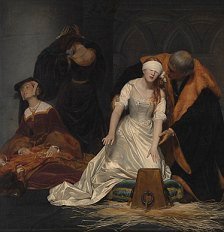
There are some historical figures so freaking awesome, I have dreams about meeting them. Lady Jane is one.
A History Buff and Her Heroes
I'm a huge history buff. I love reading about it, learning about new discoveries, and the feeling of connection it gives me with all the human race who came before me. When you read enough about history, you realize human nature changes very little over the centuries, and we're not much different than even the people of the most ancient civilizations when it comes to the fundamentals of who we are.
That's why stories like "Romeo and Juliet" are so timeless....they speak to a common human condition we can all understand and relate to, despite the centuries that separate us from those beloved characters (and, admit it....each time you read it, you hope for a different outcome for those crazy kids, don't you?).
Being so fascinated by history, it's only natural that I've got some personal heroes across the millennia. Let's face it. There were some badass champions of the people, absurdly intelligent geniuses who changed society, and extremely brave stalwarts who did what most of us would not in order to remain true to themselves. You'll find them in just about any history book; every era has its outstanding figures.
Though everyone who ever lived is important simply because they were human and they were here (which is a big reason why I do genealogy), it's only natural to feel drawn to certain historical figures. These are people who did something that speaks to you on a personal level. I admit, I've got a bit of a crush on John Adams (our nation's second president), and think the Duke of Monmouth got a raw deal (he totally should have been king).
But, for now, I want to concentrate on some of my female historical heroes, not because I'm a passionate feminist or anything, but because the women of history often get so little attention in comparison to the men. Their stories need to be heard, too.
So, every now and then, I will write a post about one of my badass historical heroines.
First up--Lady Jane Grey!
So, Who WAS Lady Jane Grey?
Lady Jane Grey was, first and foremost, a Tudor. She may not have borne that last name, but she was a close and important member of the family. While no known contemporary portraits of her exist, it is said she even had the famous Tudor red hair.
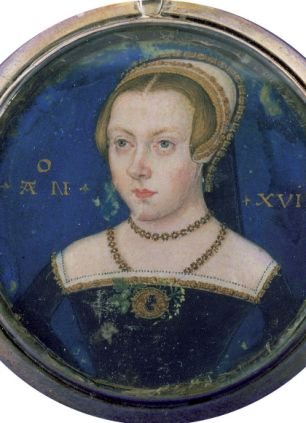
Many historians now think this painting is a contemporary one of Jane, but it's not 100 % certain. Maybe it's her.
Her maternal grandmother was King Henry VIII's younger sister. Henry had two sisters, Margaret (who was older, and became Queen of Scotland), and Mary (who was younger, and was Queen of France for a short time, and then Duchess of Suffolk).
Mary married Charles Brandon as her second husband. Charles was Henry's childhood friend and closest confidant. Together,Mary and Charles had four children--Henry, Frances, Eleanor, and another Henry. The two Henrys died in childhood, but Frances and Eleanor married and had children of their own. Frances married Sir Henry Grey, and had two boys with him who died as infants. They also had three girls who lived--Jane, Katherine, and Mary.
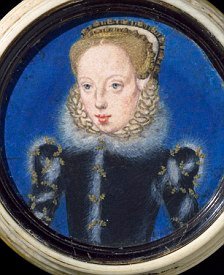
This actually IS Katherine Grey, Jane's sister, painted in her lifetime.
So, basically, Lady Jane Grey was Henry VIII's grand-niece (his sister's granddaughter).
Why Was Jane Historically Important?
Well, the first thing was the fact that, from birth, she was fifth in line to the English throne.
According to the terms of Henry VIII's will, the crown would pass from him to his son, Edward. If Edward had no heirs, it went to his daughter, Mary. If Mary had no heirs, it went to his daughter, Elizabeth.
Now, with three legitimate children, Henry never imagined none of them would produce heirs (though that's exactly what happened). Still, he made contingency plans in his will, just in case. If all of his children failed to produce heirs, the crown would go to the eldest heir of his sister, Mary.
Since both of Mary's sons died young, that meant her daughter, Frances, was next in line, and Frances's eldest living heir, Jane, was right behind her.
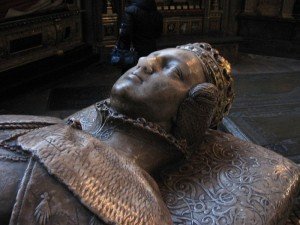
Effigy of Frances Brandon Grey, Jane's mother, in Westminster Abbey.
Normally, the crown would have passed to the heirs of Henry's older sister, Margaret. But, Henry had doubts about Margaret's chastity, and, therefore, the legitimacy of her heirs. Plus, he liked Mary better. So, he specifically excluded Margaret's heirs from the throne.
His daughter, Queen Elizabeth I, re-instated them when she became queen. After she died without heirs, the throne went to Margaret's great-grandson, James.
However, during Jane's lifetime, she was a close heir to the throne, and considered an excellent match for anyone of noble or royal breeding. In short, she was a catch on the high class marriage market, and her parents knew it.
There was much speculation in her later childhood that she would be betrothed to her cousin Edward (Henry's son and primary heir), and become his queen when he inherited the throne. They were the same age, after all, and knew each other well.
Even if she didn't marry Edward, no one doubted Jane would make a brilliant marriage to someone incredibly wealthy and important, and she was raised with this expectation in mind. This helped her get a classical education most other noble girls did not, but it also put her in the cross-hairs of the tragedy that was to come.
Jane Begins to Stand Out from the Other Royal Women of Her Time
It has to be said, Jane had a mind of her own, even from a young age. She was given an excellent education, one that was equal to her cousins ahead of her in line for the throne, and by all accounts, she loved learning. Some historians claim she had the finest mind of anyone of her generation.
She was boarded out for a time to Henry VIII's widow, Catherine Parr, and her new husband, Thomas Seymour, as they were the only ones in the realm with a higher rank than Jane's own family.
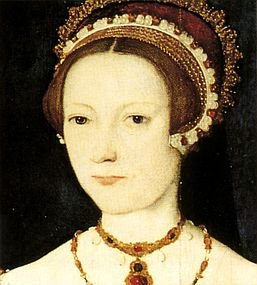
Catherine Parr, painted while she was queen.
Boarding out was a common practice among the nobility of the time, as it was thought the boarder parents wouldn't have the natural affection for a child its parents did, and so would be tougher on him or her, and thus produce a better member of noble society.
In Jane's case, it proved to be just the opposite. Her parents were, by most accounts, unusually tough on her. It was probably because she occupied such an important place in the royal and family hierarchy. She was an independent-minded girl, though, and bristled under her parents' harsh treatment of her. In Catherine Parr's household at age ten, she welcomed the warmth and affection the former queen bestowed on her.
Unfortunately for Jane and for Catherine, this happiness was short-lived. Catherine died about a week after giving birth to her only child, due to puerperal fever (or "childbed fever," as it was then known)....a condition caused by an unsanitary birth experience. Still just a child by modern standards, Jane was chief mourner at Catherine's funeral, and was required to sit vigil by her open casket for several days before the official ceremony to lay the queen to rest.
After this, Jane's parents demanded the widowed Thomas Seymour, send her home. Thomas was able to talk them into letting her stay, though it didn't last long. Already suspected of having improper relations with the then 14-year-old Princess Elizabeth, who was also being boarded by he and Catherine, he soon got in real trouble when he hatched a plot to abduct and marry her shortly after Catherine died.
With Thomas in the Tower, and his baby daughter with Catherine being raised under protest by her step-grandmother, Jane went back to her parents after all.
How Jane Coped With Having Cruel Parents
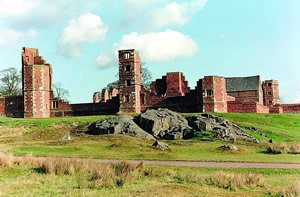
The ruins of Bradgate, Jane's childhood home.
Once back with her parents at their home at Bradgate, Jane was permitted to continue her studies. But, she was nearing puberty, and her parents felt the time for studying would soon be over; she would need to be married to a suitable candidate before long.
Jane didn't seem to enjoy living with her parents once more. So, she took refuge in the learning she loved so much.
One of her old tutors, who came by Bradgate for a visit when Jane was 14, found her sitting alone, reading Plato in the original ancient Greek text, while her family was out hunting. He asked why she did not join them, and he was so affected by her reply, he recorded it in writing for posterity.
Here's what Jane told him (quote edited for modern language and spelling, as well as brevity):
" I will tell you a truth which, perchance, you will marvel at. One of the greatest benefits that ever God gave me is that he sent me so sharp and severe parents, and so gentle a schoolmaster. For, when I am in presence either of father or mother, whether I speak, keep silent, sit, stand, eat, drink, be merry or sad, be sewing, playing, dancing, or doing anything else, I must do it ever so perfectly as God made the world, else I am so sharply taunted, cruelly threatened, and yes, sometimes with pinches, nips, and bobs, and other ways which I will not name for the honor I bear them, that I think myself in hell, till the time comes that I must go to my tutor, who teaches me so gently, so pleasantly, and with such fair allurements to learning, that I think all the time of nothing else while I am with him. And, when I am called from him, I begin weeping, because whatever else I do but learning is full of grief, trouble, fear, and is wholly misliking unto me."
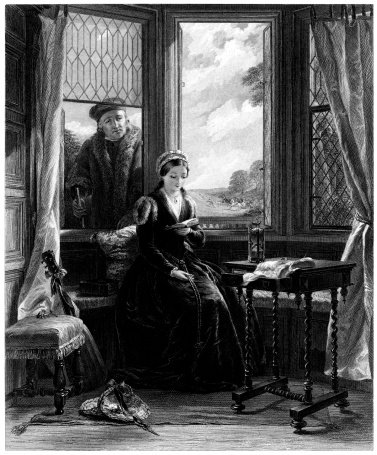
Famous 19th century engraving of the famous meeting between Jane and her former tutor.
Obviously, her parents were harsh people. Some of it can be attributed to the common child-rearing practices of the 1500's. However, the fact her former tutor saw fit to comment on it suggests what her parents were doing to her was outside the norm.
It is very likely much of their harshness toward Jane was because they had big ambitions for her, and they wanted her to appear perfect in every way so she could become a royal bride.
Jane Takes on National Importance
Jane's parents intended for years to arrange a marriage between her and her cousin Edward, who by the time both he and Jane were nine years old, had succeeded Henry VIII as King Edward VI.
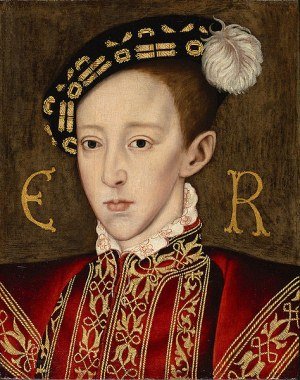
King Edward VI
However, by the time Jane reached a marriageable age, it was clear this was not going to happen. Edward was ill with tuberculosis, and, though it was kept a secret from the nation for a long time, those closest to him knew he would not live to marry and produce heirs.
A different and equally important husband had to be found for Jane.
The answer came in a proposition from John Dudley, Duke of Northumberland, and current Lord Protector during Edward's minority as king. John was the father of many children, all suitably noble. Most of his sons were already married, but his youngest, Guildford, was not. Even better, he was only two years older than Jane.
John also had the ear of the dying boy king. At fifteen years old, Edward already knew the direction he wanted the country to go, and was beginning to take part in ruling directly when he became ill. It didn't take much convincing on John's part to get Edward to agree to make Jane his heir.
After all, the next person in line after him was his half-sister, Mary, and she was a Catholic. With England largely turning toward Protestantism, the last thing Edward wanted was for his sister to bring the realm back under the control of the Pope.
Though Jane's mother was technically next in line, she gave up her place in favor of Jane. Edward wrote his will, naming Jane as his heir. He also excluded both Mary and his other half-sister, Elizabeth, from the succession by naming them as bastards. Jane, like Edward, was a staunch Protestant. He knew he could trust the country in her hands.
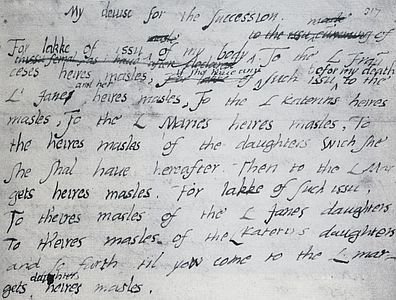
Edward VI's will naming Jane as his heir.
Jane was conveniently forced to marry Guildford Dudley just before the will was written. It is said she protested the marriage quite vocally, and had to be literally beaten into submission before she would agree to it.
These machinations made it clear John Dudley and Jane's parents thought they would be the real power behind the throne when their two teenagers were crowned.
Jane Shows Her True Colors, and They are Beautiful and Vivid
Jane hadn't been married long when Edward died. She had no idea he named her his heir. So, when one of Guildford's sisters came to their home and told her she was wanted at court, she thought it was to pay respects to her deceased cousin.
When she arrived, everyone around her bowed, including her parents, and she was informed by John Dudley that she was queen.
She was horrified.
At first, being fifteen years old, she collapsed crying on the floor. That no one made a move to comfort her is telling. She then protested that the crown was not hers by rights, that it belonged to her cousin Mary.
After much coercion on the part of her parents and John Dudley, she prayed on it, and then decided that if God gave her this role, she must accept it, as it was His will. Thus, she resolved to be queen and to do her best at it.
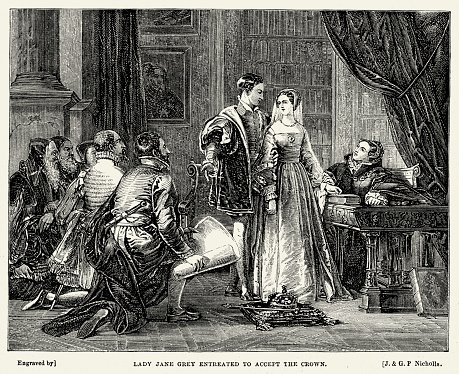
19th century engraving of Jane being coerced into taking the crown.
Then, one of the ministers of the court approached her with the actual crown, wanting to see if it would fit on her head or need adjusting. He suggested he take measurements for Guildford, because he would be needing one, too.
This is when Jane really stepped up and showed that she intended for no one to rule over her now that she was queen.
She told the minister, and everyone in the room, that, while she would be happy to make Guildford a duke, there was no way she was making him king.
Guildford had apparently been promised the kingship by his parents if he became her husband, and he wailed and protested her refusal to crown him. When she maintained her position, he, along with his mother (who is said to have favored him above all her other children), turned to leave the throne room.
Jane had a guard stop them.
She was queen now. She wasn't messing around.
She said his mother was free to go, but, as her husband, Guildford's place was beside her, and she ordered him to stay. As his queen, he could not refuse, and she made sure all the guards in the palace knew to keep him there with her.
Before she left, his mother told Guildford he should avoid sleeping with Jane anymore until she relented on the crowning; she would need heirs, after all, and how would she get them if her husband wouldn't have marital relations with her?
Jane the Queen
While Jane was technically queen, simply because she had possession of the crown, she was not yet coronated, and her queenship wasn't completely legal. Edward's will had to be ratified by Parliament for it to become law and override the will of Henry VIII.
There wasn't time to get that done before Edward died, so Parliament swore to defend Jane as queen until it could be legalized. This was the only way to prevent Mary from taking the throne as soon as she heard about Edward's demise.
The people of England, though most of them were turning to Protestantism, still had a strong sense of loyalty to the royal family, and most of them believed Mary was the rightful heir, regardless of her religion or Edward's will.
The Nine Day Rule
For nine days, Jane acted as queen, signing documents, issuing orders, sitting in on meetings with her advisors and ministers, and getting ready for her coronation. Meanwhile, in the world outside, Mary was gathering an army, and the towns and villages she rode through on the way to London declared her queen, one after the other.
By the time Mary reached London, all of Jane's advisors except her father had abandoned her and declared their support for Mary. Even John Dudley did, once he was captured while fighting her army with a small group of his own men.
Jane's father told her she was no longer queen. Being an innocent and naive teenager, she asked if she could go home. She was relieved to not be queen, as she never wanted it in the first place, and she felt the rightful queen was getting the role.
Her father already knew Jane was a prisoner, and he apologized to her, saying he was but one man, before leaving her alone in the palace to face Mary's guards without anyone to support or comfort her.
Jane in Limbo
Mary had known Jane all Jane's life, and was very close with Jane's mother, Frances (she and Frances were first cousins). They'd spent holidays together, exchanged gifts, and had long talks about religion, even when Jane was very little. Mary had a fondness for her, even if she thought her little cousin was a Protestant heretic.
Still, Mary knew she couldn't let Jane go just yet, because the people saw her as an interloper and pretender to the throne.
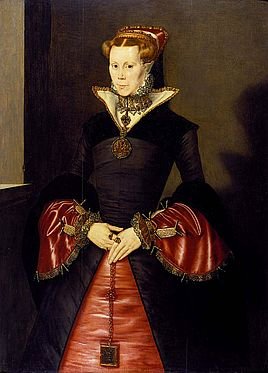
Queen Mary Tudor, daughter of Henry VIII and Half-Sister to King Edward VI
Guildford was a prisoner, too, just because he was married to Jane. That was literally his only crime.
In a private meeting with Jane, Mary assured her teenage cousin that she would only keep her prisoner until all the fuss over the messed up succession to the throne blew over. It was widely talked about at court, too. Everyone expected Mary to free Jane.
In the meantime, Jane was given comfortable lodgings with the constable of the Tower and his family, and treated like the royal person she was.
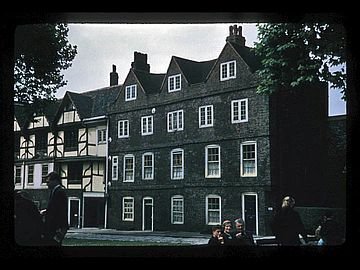
Jane's lodgings while prisoner at the Tower of London.
John Dudley, the known mastermind behind Jane becoming queen, was executed not long after. Not even his last-minute conversion to Catholicism to appease Mary could persuade her to spare him.
Jane's parents were let off with a warning, probably because of the lifelong close friendship that Frances and Mary shared.
Jane might actually have been freed and allowed to live her life as a normal young woman of the nobility if her father hadn't done something monumentally stupid.
Mary was engaged to marry Phillip of Spain, the heir to the Spanish throne. Many people in England disapproved of this marriage, because Spain was a more powerful country, and they were concerned Mary would let England become a vassal state of the Spanish empire. Jane's father was among the dissidents.
Even though Mary generously spared his life before, Henry Grey went out with a band of rebels determined to stir up more dissent in the nation, and while doing so, he publicly proclaimed Jane as queen.
After that, Mary knew she could not be safe on her throne as long as Jane lived, even though she also knew Jane was forced onto the throne and didn't do anything wrong. Furthermore, Phillip refused to come to England and marry Mary as long as Jane remained a threat to their co-rule.
Mary had no choice but to order Jane's execution.
While she was at it, she ordered the executions of Jane's father, and Guildford, too.
Jane Displays a Will and Spirit that Could Not Be Broken
Before she was willing to execute her young cousin, though, Mary tried to get her to convert to Catholicism. She thought if Jane were Catholic, she would no longer be a Protestant figurehead who others could use as an alternative ruler to Mary, and would therefore be harmless. It was her hope that Jane would convert, Phillip would come to England, and she could set Jane free, as she'd promised.
She sent her own priest to talk to Jane many times, but their talks only irritated the girl, who was trying to prepare her soul for heaven. With her refusal to convert to save her life, the execution was set to go forward.
What other 16 year old girl would refuse to back down on her religious convictions in the same situation?
Jane also showed she was no pushover, and knew exactly what had been done to her. Shortly before her execution, she wrote letters to many people she was close to, including her sister Katherine, and the constable of the Tower in whose home she was imprisoned. She also wrote to her father, who was in another cell in the Tower at the time.
In her letter to him, she described herself as his devoted and obedient daughter, but also chided him for shortening her life with his actions, when, as her father, he should have wanted to lengthen it.
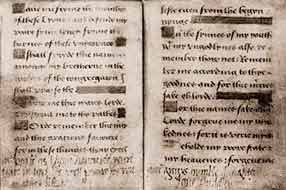
Jane's letter to her father, written in the margins of the prayer book she carried to the scaffold with her.
No known letter to her mother exists, and it is telling of their likely relationship that Jane's mother begged Mary for the life of her husband, but not for Jane. It is also telling that after Jane and her father were executed, two weeks apart from one another, that the wily Frances was given a place as a maid of honor in Mary's court, along with Jane's two sisters.
Frances Grey didn't appear to hold any grudges against Mary for the execution of her daughter and husband, either. Her royal ambitions for her and her remaining daughters were still firmly in place.
Guildford asked to see his wife in person one more time before they were executed. This request was made the day before their executions were scheduled, and Mary agreed to it. Jane did not. She said she would rather they leave things as they were in this life, and meet again in a new one where she hoped they would be better friends.
She did promise to watch from her window as he walked to his execution the next day. This is a promise she kept, and she waved to him as he went.
While Jane's attending ladies reported she cried when she saw the cart bringing Guildford's bloody, headless body back to the Tower after his public execution just outside its walls, the tears were brief and fleeting.

Tower Hill, just outside the walls of the Tower of London, where Guildford was executed.
Brave to the End
When it came Jane's turn to go to the scaffold, shortly after Guildford's body was returned to the tower, she went bravely. She even asked Mary's priest, whose conversion attempts had so annoyed her, to accompany her and stand with her there, since she actually liked him in spite of their religious differences. He was touched, and eagerly agreed.
She gave a brief speech to the invited guests who came to see her private execution within the tower walls (something she got that Guildford didn't, because of her royal status), asking them to pray for her while she was still alive, instead of after she was dead, as was the Catholic custom. She also recited the Lord's Prayer.
Only sixteen years old, she faced her execution by beheading with grace and dignity, never faltering in her speech, or showing any apprehension. She even asserted her well-known independent spirit once more by refusing help with putting on her blindfold, and insisting on doing it herself.
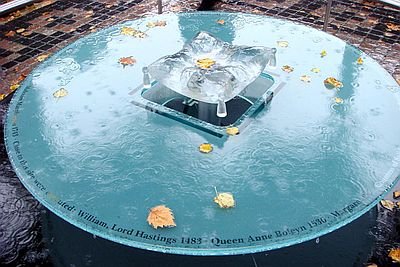
Memorial to those executed on Tower Green, within the Tower walls, including Jane
The only thing she seemed to be concerned about was whether the executioner would behead her before she indicated she was ready. In royal executions the condemned traditionally gave a sign they were ready to be dispatched to the next world by raising their arms out to their sides. When the executioner assured her he would wait for her signal, she visibly relaxed.
She knelt a little bit too far from the block, and could not see it through her blindfold. When she couldn't find it she grew concerned again that the executioner would behead her before her signal, and she cried out, asking where he block was, and what she should do. It was the only time during the entire proceeding that she lost her composure. Many grown men throughout history have been reduced to begging and tears at the mere sight of the scaffold.
Not Jane.
Conclusion--The Making of a Legend
Once an anonymous person (who history does not identify) took her hands and helped her find the block, she calmed down instantly. It seemed to comfort her to have her hands on it, and regain some control over the situation.
Jane had so little control in her life, due to social norms for women at the time and her own royal position, she liked to exercise it where she could.
With her head on the block (and her mother comfortably set up as an attendant to the very queen who was ordering this execution), Jane said a few more quiet prayers, then gave her signal.
Being young, and smaller in height than average for her age, she was fortunate that the executioner took her head off with one swing. Plenty of others were not so lucky.
Both Jane and Guildford, along with their respective fathers, were buried side by side under the floor of the Tower chapel of St. Peter-Ad-Vincula. Though, in Jane's case, permission for a burial there had not been obtained from Mary before the execution, and so her body had to lay exposed on the scaffold for over four hours, attended to and guarded over by her grieving ladies, until permission was granted.
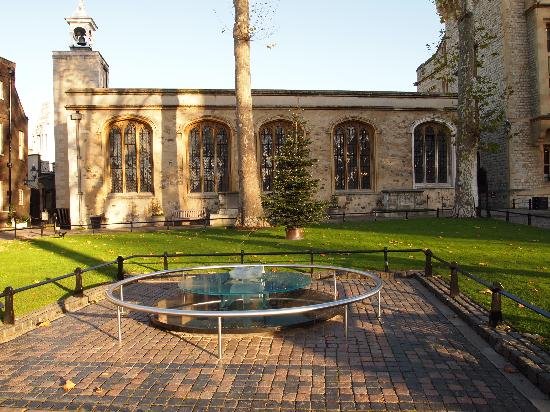
The Chapel of St. Peter-ad-Vincula, where Jane is buried, with the execution memorial in front of it.
Inside the chapel of St. Peter-ad-Vincula. Jane is buried under the floor, near the pulpit. Marker showing where Jane, Guildford, and Jane's father are buried in the chapel. Anne Boleyn's marker is on the tile floor just above it. Lady Jane Grey may not have played a huge or defining role in English history, but the role she did play was dramatic, and not to be forgotten. Very few young girls were willing or able to assert their own will at all in the 1500's in England; Jane was prepared to do so when it was important to her, and not afraid to face the consequences of it when she did. This makes her stand out as a historical person and gives her the qualities of someone I consider a hero. Her commitment to stand by her convictions no matter what, her willingness to go against societal expectations when she felt it was the right thing to do, the way she was always true to who she really was as a person, and her unwavering courage in the face of truly horrible obstacles and atrocious circumstances make her one of my badass heroines of history. Here's to Queen Jane. Cary Elwes and Helena Bonham Carter as Guildford and Jane in the 1986 movie, "Lady Jane."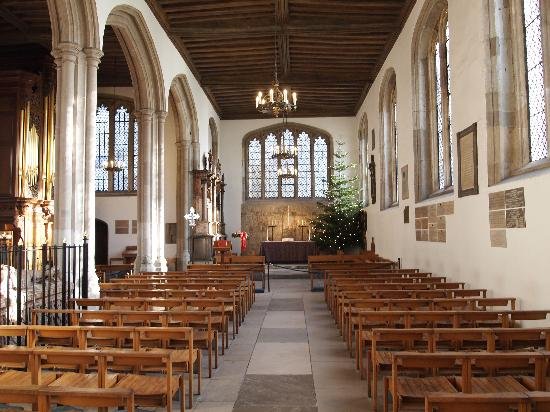
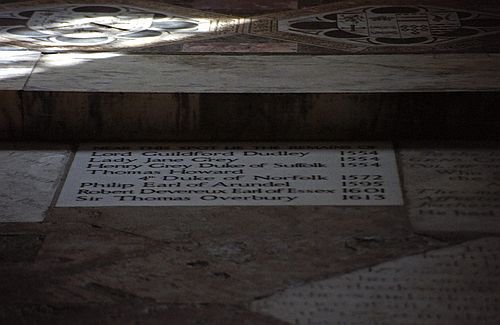

If you enjoyed this post, please follow me at @stephmckenzie for more intriguing articles on life, the universe, and everything.
Thanks for sharing. One can cry for Jane.
I also love history and have done an article about Charles Darwin if you are interested.
Thanks! I'll have a look.
excellent quality your post, I love congratulations
Thank you, @jlufer. I appreciate it.
Post included in: Steemprentice spotlight #3 - Steemit Mentors and Mentees helping everyone steem better!
Excellent! Thank you so much. I appreciate you including me in the list.
You are most welcome! :)
More of these please!!!!

The girls and women of history do rock. There are a lot of incredible female historical heroines. I'll write about more of them here and there. I'm glad you enjoyed the post. :)
I had no idea about Lady Jane, thanks for the education!
I'm glad you enjoyed it. Lady Jane was a cool girl, and I admire her very much.